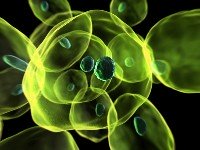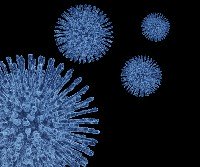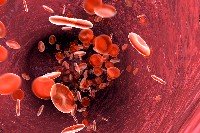What are Glyconutrients?
 Cell to Cell Communication with Glyconutrients |
Your body is made up of millions and millions of individual cells...and Glyconutrients have a very important role to play in your body's cellular structure and function. Incidentally, you can also use the terms
Monosaccharide's, Polysaccharides,Glycans and Glycan as interchangeable terms.
The cells of your body are arranged into communities that form tissues and body organs which in turn form the individual systems that make up your body such as your digestive system or your cardiovascular system.
The cellular communities in your body are constantly at work..
- repairing
- renewing
- regenerating defending and protecting you..
each individual cell working like a tiny machine
|
to your health Available now. Click here |
If you're thinking that sounds like hard work then you are absolutely right. Each individual cell requires regular nourishment and the removal of waste in order to operate optimally.
When your cells
require nourishment, waste removal or protection from invaders they send
out messages and 'ask' for what they need.
Let's take a closer look.
 Cell Surface Sugars and Proteins form Glycoproteins |
The exterior surface of an individual cell in your body is not smooth but is actually covered in a dense forest that looks like fur! Close up this fur looks like individual tree-like structures. These tree-like structures consist of two components: Protein stem - attached to the surface of the cell - a tree trunk if you like... and.. Sugar molecules - the tree branches.
|
Science has shown that these sugar molecules on the cells surface consist of various combinations of a key group of eight monosaccharide's. An almost infinite number of combinations is available when your cell apparatus is coding these sugars which together with its paired protein..punch through the wall of the cell and 'take root' on the surface |
Scientific research also tells us that the combinations of sugars on a cells surface form different three dimensional shapes which lock into...
- neighboring cells
- traveling cells such as can be found in your immune system
- hormones and even viruses and bacteria
Quite simply, these monosaccharide structures are how a cell sends and translates messages about what it requires and what condition it is in. A cell actually 'talks' using various combinations of sugar molecules..amazing!
|
Make Sure Your Glyconutrient Supplement Contains All Important Sugars for Optimal Cellular Function and is Scientifically Validated. |
Now let's take a look at that strange word….what does the term Glyconutrient actually mean?
Glyco is the Greek word meaning sweet and nutrient is a nutritional component...so..
These Glycans are actually a sugar molecules that are nutritious!
Glyconutrients are not table sugar....but they are in the broad category of the family of sugars of which there are about 200.
|
Glyconutrients don't cause weight gain or interfere with your blood sugar levels and are utilized by your body as far more than an energy source.....they are so vital for the correct structure and function of your cells that you couldn't survive without them |
Why do I need Healthy Sugars?
Four key tasks that involve these biologically important sugars are..
- Cellular Communication - Cells asking for nourishment, waste product removal and protection
- Structural Integrity - Are major components of connective tissue and act as a tissue glue
- Physical Protection - Competitively block viruses and bacteria from penetrating and binding to a cell
- Cellular Adhesion - Involved in Platelet(Blood)aggregation(stickiness)
 Monosaccharides Prevent Reperfusion Injury Post Ischemia |
One of the eight essential Glyconutrients is called Fucose - pronounced foo-cose or few-cose (Fucose is not Fructose).
Research has found that fucoidans show potential in preventing reperfusion injury post-ischemia.
Reperfusion injury can occur in tissue that has been starved of its blood supply and can cause death and damage to tissue that has had its blood supply restored.
A rich source of Fucose is found in nature in a marine environment in a species of seaweed called Undaria Pinnatifida.
The Fucose from this species of kelp is highly effective in inhibiting viral attachment and as a fibrinolytic agent. (breaking down of blood clots) also known as clot lysing.
|
Ideally, Glycans should be a part of your daily diet as they are components of plant foods. However, two of the essential eight are the only ones that are found in any abundance in a typical westernized diet..and Fucose is not one of them |
Although these nutrients can have a profound effect on the normal operation of your body's physiology they are not pharmaceutical agents and shouldn't be thought of in that way.
So how do people survive if they are getting so few biologically important sugars in their diet?
One could argue that the general health of populations is not in good shape..given the health statistics..so it is likely that people are not doing well without regular optimal nutrition..
however..to answer that question...
Glyconutrients are so important that your body has a backup system. Your liver can actually attempt to synthesize these essential sugars from available glucose that is in your diet.
The problem is that this is a very complex and multi stepped process inviting potential errors, process in-completion and is time and resource intensive.
It's a bit like going to a factory every time you need a bolt and having one made instead of having a ready assortment in a large bucket right there for you to choose from!
If a community of your body's cells
requires Glyconutrients now but there is none available and your liver
has to manufacture them to order...how will this effect the performance
of that group of cells if they have to wait? Enough time for cancer cells to multiply unchecked due to poor cellular messaging perhaps?
What else could happen in your body if your liver cannot fill that order because it has too much work on fulfilling other body requirements?
Nursing infants get five of the essential eight Glyconutrients from mothers breast milk..but from there on in it is very difficult for you to get an adequate daily supply of these nutrients.
Daily supplementation seems to be the only answer and it is my recommendation that Glyconutrients form the dietary corner stone of anyone concerned about their health.
Go from Glyconutrients to Heart Health Supplements
Click here to go from Glyconutrients to Coronary Heart Health Home Page
|
every biological process and are involved in every major disease". Read more about what the National Acadamy of Sciences has to say about the importance of Glycans....also known as Glyconutrients, Carbohydrates, Saccharides or simply as Sugars... healthy sugars. Download the Pdf NOW and read about this for yourself Click here to read Importance of Glycans in Health and Disease in your browser or right-click to download it. |



